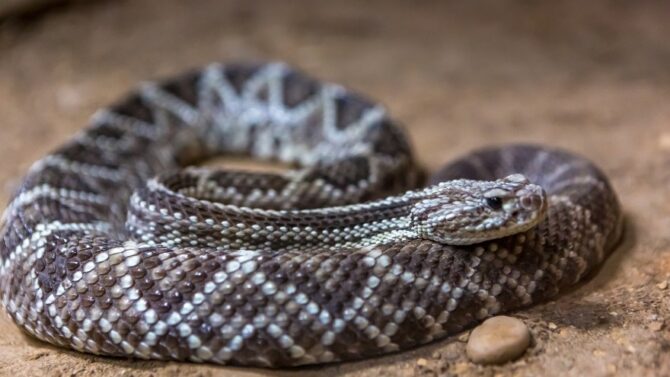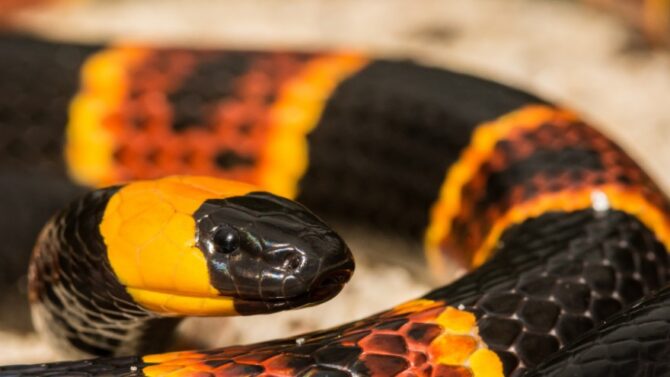The United States is home to many owl species.
Some are residents that can be seen all year round, while others migrate seasonally.
These owls can be found in different states and cities, like Oklahoma and North Carolina.
In Maryland alone, there are 10 owl species you can encounter, such as the barn owl, the eastern screech owl, the flammulated owl, and the long-eared and short-eared owl.
Owls are truly remarkable creatures, so read on to learn more about the species of owls in Maryland.
10 Species of Owls in Maryland
1. Great Horned Owl
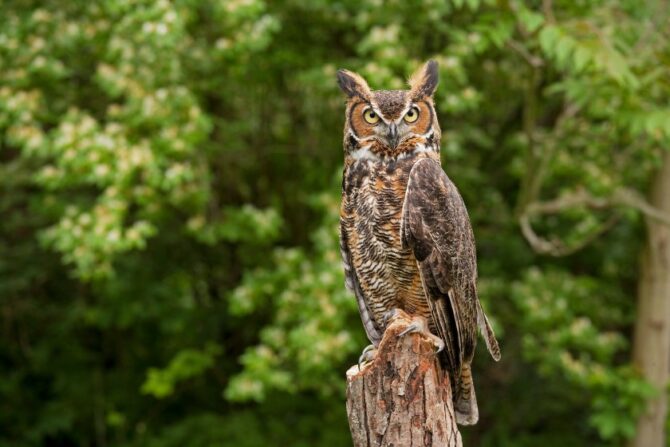
- Length: 18 to 25 inches
- Weight: 2.2 to 3.8 pounds
- Wingspan: 36 to 60 inches
- Scientific Name: Bubo virginianus
The great horned owl is the largest owl species in Maryland and one of the largest in the world.
It is also the most widespread true owl in the Americas, its native region.
Besides Maryland, you can find the bird in other parts of the United States, Canada, South America, and a few in Central America.
As the name already reveals, this species is recognized by its distinct long ear tufts, which look like horns.
Its plumage is predominantly gray-brown and mottled, excellent for camouflaging.
It also has an underside that’s usually lighter in color and a white patch on its throat.
Great horned owls dwell in deserts, woods, grasslands, and even urban areas.
Their vocal call is a hoot, which is low in pitch but loud enough for you to be aware of their presence.
As a predator, the great horned owl is nocturnal and feeds on rodents, small mammals, and reptiles.
2. Barn Owl
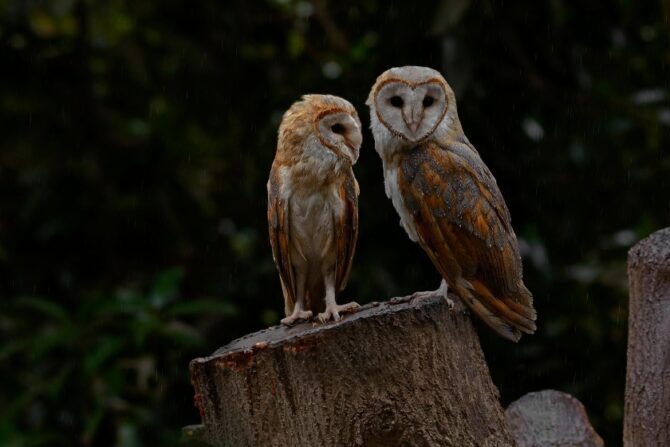
- Length: 13 to 15 inches
- Weight: 1 to 1.5 pounds
- Wingspan: 40 to 50 inches
- Scientific Name: Tyto alba
The barn owl is not very common in Maryland, but as a resident bird, you can find it all year round.
These owls aren’t limited to Maryland or even to the Americas.
In fact, they are the most widely distributed owls, occurring in every continent except Antarctica.
The barn owl derives its name from the fact that it usually nests in barns.
Its alternative names include church owl (as it is also found in churches) and monkey-faced owl (because its face is sometimes shaped like a monkey).
Some people consider barn owls dangerous because they have pale faces, but nothing could be further from the truth.
These birds are completely harmless to humans.
Besides its pale face, you can recognize the barn owl by its buff back, long wings, and short tail, which distinguishes it from true owls.
Contrary to popular opinion, Its vocal call is a screech, not a hoot.
3. Eastern Screech Owl
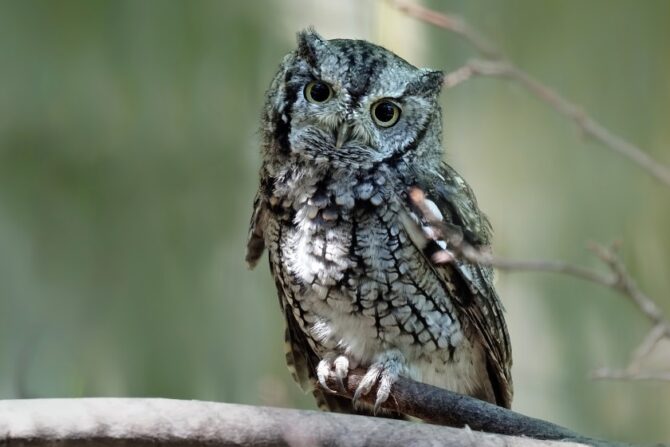
- Length: 6 to 10 inches
- Weight: 0.37 to 0.43 pounds
- Wingspan: 19 to 24 inches
- Scientific Name: Megascops asio
The eastern screech owl is common in Maryland and other parts of the United States, Mexico, and Canada.
It is non-migratory and can be found in Maryland all year round.
Like the great horned owl and the barn owl, the eastern screech owl is nocturnal.
Its overall plumage is dark gray or rusty brown and adorned with patterns all over and a touch of red.
The eastern screech owl is also short and stocky, with a short tail and broad wings.
There are two color variations of the eastern screech owl: the red and rufous morph and the gray morph.
The eastern screech owl is usually compared to its relative, the western screech owl, and lives more in wooded areas, like deciduous forests, woodlands, parklands, and suburban wooded places.
Contrary to its name, the eastern screech owl does not screech.
Instead, its vocalizations resemble a whinny sound.
As for its diet, the eastern screech owl preys on smaller birds, insects, mammals, and reptiles.
4. Barred Owl

- Length: 17 to 20 inches
- Weight: 1.4 to 1.8 pounds
- Wingspan: 38 to 49 inches
- Scientific Name: Strix varia
The barred owl is a resident of Maryland and can be found all year round.
As a native of North America, this bird lives in other parts of the continent as well.
The barred owl is a true owl, like the great horned owl, and is around the size of a crow or a goose.
Its plumage is a grayish brown or brown with distinct stripes on the belly and back, which is where it gets its name from.
The barred owl is characterized by a round head with no ear tufts, a round tail, and black eyes.
This fascinating bird is usually found in mixed forests, deciduous woodlands, and coniferous forests.
It is often seen around water bodies in its habitat.
As a true owl, its vocalization is a hoot.
Barred owls are opportunistic predators that prey on rats, shrews, voles, fish, earthworms, crustaceans, reptiles, and amphibians.
5. Long-Eared Owl
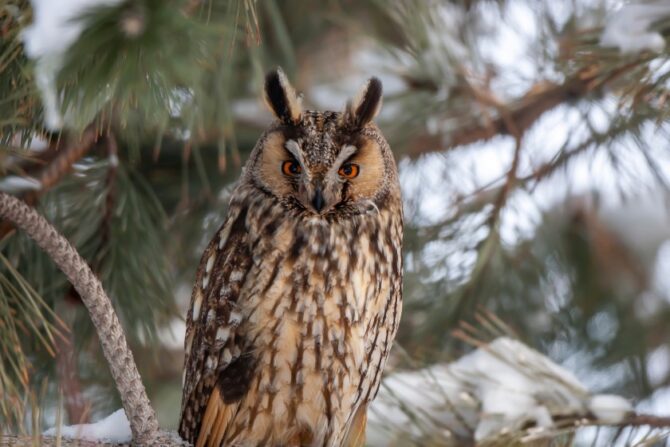
- Length: 14 to 16 inches
- Weight: 8 to 15 pounds
- Wingspan: 36 to 40 inches
- Scientific Name: Asio otus
The long-eared owl, also known as the cat owl, the lesser horned owl, or the northern long-eared owl, is a resident of Maryland.
This owl species can be found in Maryland throughout the year, although it travels within the state.
Beyond Maryland, it also inhabits other parts of North America, Europe, and the Paleartic.
The long-eared owl is characterized by its slender body, protruding ear tufts, long wings, yellow eyes, and buff-brown facial markings.
Its plumage is colored brown and black with patterns.
The long-eared owl dwells in open spaces with vegetation, especially areas with mature trees.
It can be found in different forests, swampy areas, gardens, parks, and even cemeteries.
As a bird of prey, the long-eared owl primarily hunts rodents and other small mammals.
6. Short-Eared Owl

- Length: 13 to 17 inches
- Weight: 0.45 to 1 pound
- Wingspan: 33 to 43 inches
- Scientific Name: Asio flammeus
The short-eared owl is a relative of the long-eared owl—both birds belong to the same genus (Asio), commonly known as ear owls.
Unlike its relative, the short-eared owl is a migratory species that travels to Maryland during winter after the breeding season.
This owl is widely distributed across all continents except Antarctica.
The major difference between the short-eared owl and its relative lies in the size of their ear tufts.
While the long-eared owl’s tufts are clearly visible when perched, the tufts of the short-eared owl are barely noticeable.
Although it has brown plumage like the long-eared owl, the short-eared owl’s coloration is also paler.
Its tail and wings are marked with bars, and since its wings are broad, the short-eared owl flies are like a bat or a moth.
This owl species also has a short black bill, a big head, and a short neck.
The short-eared owl inhabits open country and grasslands, although it will travel to other areas as long as enough food is available.
Its vocalization is raspy and tends to be noisier when the bird is breeding.
However, the short-eared owl usually remains silent on wintering grounds.
Its diet consists mainly of rodents, though it can also feed on bats and shrews.
7. Flammulated Owl

- Length: 6 to 7 inches
- Weight: 0.11 to 0.14 pounds
- Wingspan: 15 to 16 inches
- Scientific Name: Psiloscops flammeolus
The flammulated owl is a migratory bird, so chances of seeing it year-round in Maryland are low.
This small-sized owl is the only species classified under the genus Psiloscops.1
The flammulated owl is a native of North America, though it can migrate to the central and southern areas as well.
The flammulated owl derives its name from the marks on its face, which look like flames.
Another outstanding quality it has is its broad wings, which are large compared to its body and help it fly swiftly around trees.
The flammulated owl has a bluish-gray plumage; it is often compared to the western screech in appearance and the mountain pygmy owl in size.
The flammulated owl dwells in deciduous forests and feeds predominantly on insects.
Only on some occasions does it eat small mammals.
8. Burrowing Owl
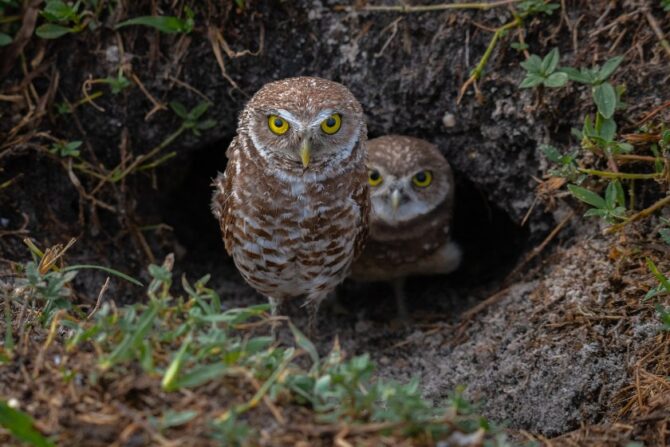
- Length: 7 to 10 inches
- Weight: 0.31 to 0.53 pounds
- Wingspan: 20 to 24 inches
- Scientific Name: Athene cunicularia
The burrowing owl, also called the shoco, is a native of both North and South America, usually found in the landscapes.
Although it’s a resident of Maryland, it is rare to see these birds in the state, especially because of their camouflage.
Burrowing owls differ from other owl species by living in burrows (hence the name) and being diurnal.
They have long legs, which they use to navigate open landscapes.
Their plumage is a combination of brown and white with spots and dark brown bars on their bellies.
Their eyes are bright, and their beak is either dark yellow or gray.
Burrowing owls are known to bob their heads when agitated, which earned them the name “howdy birds.”
These birds prefer to inhabit open country, beaches, and grasslands.
Rather than make their nests or dig their holes, burrowing owls stay in abandoned holes dug by animals like prairie dogs and squirrels.2
They also feed on insects and other small animals.
9. Snowy Owl

- Length: 21 to 28 inches
- Weight: 3 to 6.5 pounds
- Wingspan: 50 to 60 inches
- Scientific Name: Bubo scandiacus
The snowy owl, also known as the polar owl, the white owl, and the Arctic owl, lives mainly in the Arctic tundra, which makes them visitors to any other place they are found.
These birds migrate to Maryland during the winter,3 which is the only time they can be found there.
Over time, their names and colors have made them indicators of climate change.
The snowy owl is predominantly white, though it is rare to see an individual that’s completely white.
Usually, these birds have black or brown patterns on their bodies.
Adult male snowy owls tend to be whiter than females and juveniles. They are also as large as a crow.
While the snowy owl is diurnal, it can be hard to spot them because it is usually quiet and stays put.
Snowy owls primarily hunt small mammals, like lemmings, and are known for their voracious appetite.
10. Northern Saw-Whet Owl
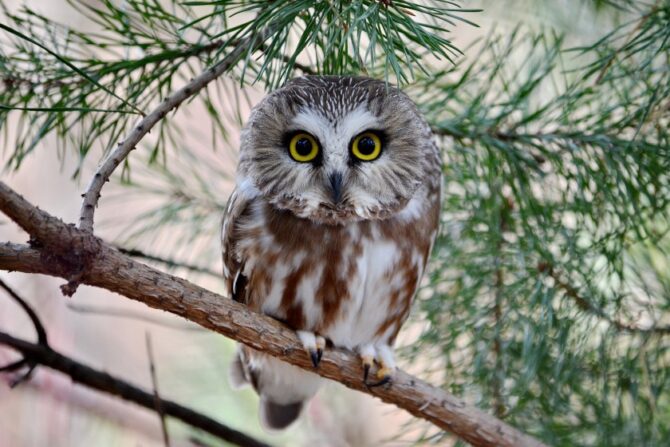
- Length: 7 to 9 inches
- Weight: 0.12 to 0.33 pounds
- Wingspan: 17 to 22 inches
- Scientific Name: Aegolius acadicus
The Northern saw-whet owl is a resident of Maryland and can be found all year round.
As a native of North America, it occurs in other parts of the continent as well.
The Northern saw-whet owl is as small as a robin and is considered one of the smallest owls in North America.
Its name is derived from its vocal call, often described as “a saw being sharpened on a whetstone.”
The northern saw-whet owl is similar to the short-eared owl.
It is characterized by a mottled brown plumage adorned with white spots, which are also visible on the face and spherical head.
Despite how common it is, spotting the northern saw-whet owl can be challenging due to its small size.
Your best chance to find it is to look for it in habitats like coniferous forests and mixed and deciduous forests.
Wrapping Up
There are 10 species of owls in Maryland, most of which are residents and can be found throughout the year.
The largest of these owls is the great horned owl, while the smallest is the northern saw-whet owl.
As most of these owls are residents, they can easily be found in their habitats.
In contrast, the migratory owl species in Maryland often appear during winter.
References & Notes
- Flammulated Owl Psiloscops flammeolus. Avibase
- Tiny burrowing owls find safer homes with the help of these scientists. National Geographic
- Snowy Owl. Maryland Department of Natural Resources



